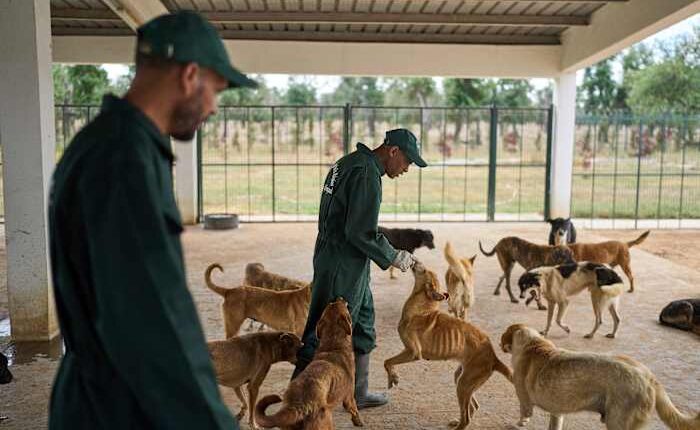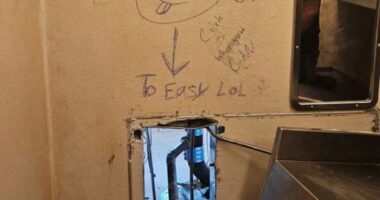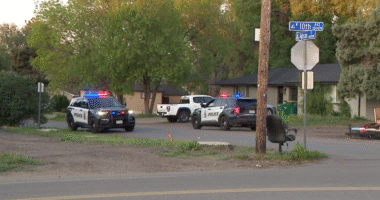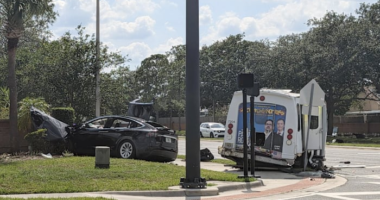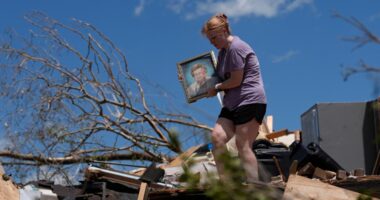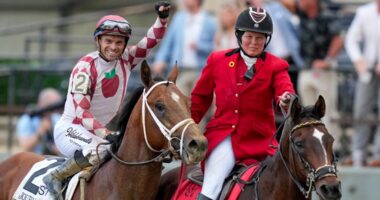
EL AARJATE – A mixed-breed dog with a blue tag attached to her ear whines as she is lifted out of a cage and transported to an operating table for a spaying procedure and a rabies vaccination, two crucial measures before she is returned to the streets of Rabat, the capital of Morocco.
Referred to as “Beldi,” the Moroccan street dogs are part of the group relocated from Rabat to a canine shelter situated in a nearby forest. Under an extended program known as “Trap, Neuter, Vaccinate, and Return,” dogs like her undergo evaluation, medical intervention, and subsequently reintegration into the community with tags indicating they pose no threat.
“We are faced with an issue: the presence of stray dogs. Therefore, we must address it in a manner that upholds animal welfare,” stated Mohamed Roudani, the head of the Department of Public Health and Green Spaces within the Interior Ministry of Morocco.
Trying to balance safety and animal well-being
Morocco adopted “Trap, Neuter, Vaccinate and Return,” or TVNR, in 2019. One facility has opened in Rabat and more are set to be launched in at least 14 other cities, aligning Morocco with recommendations from the World Organization for Animal Health. The government has spent roughly $23 million over the past five years on animal control centers and programs.
Roudani said Morocco’s updated approach balanced public safety, health and animal well-being. Local officials, he added, were eager to expand TVNR centers throughout the country.
Though population estimates are challenging, based on samples of marked and tagged stray dogs, Moroccan officials believe they number between 1.2 to 1.5 million. Some neighborhoods welcome and care for them collectively. However, others decry their presence as a scourge and note that more than 100,000 Moroccans have needed rabies vaccinations after attacks.
A draft law is in the works that would require owners to vaccinate pets and impose penalties for animal abuse.
Inside the center
On a visit organized for journalists to a TNVR center in El Aarjate, enclosures for dogs appear spacious and orderly, with clean floors and the scent of disinfectant. Food and water bowls are refreshed regularly by staff who move between spaces, offering gentle words and careful handling. Some staff members say they grow so attached to the dogs that they miss them when they’re released to make space to treat incoming strays.
Veterinarians and doctors working for the Association for the Protection of Animals and Nature care for between 400 and 500 stray dogs from Rabat and surrounding cities. Dogs that veterinarians deem unhealthy or aggressive are euthanized using sodium pentobarbital, while the rest are released, unable to spread disease or reproduce.
Youssef Lhor, a doctor and veterinarian, said that aggressive methods to cull dogs didn’t effectively make communities safer from rabies or aggression. He said it made more sense to to try to have people coexist with dogs safely, noting that more than 200 had been released after treatment from the Rabat-area center.
“Slaughtering dogs leads to nothing. This TNVR strategy is not a miracle solution, but it is an element that will add to everything else we’re doing,” he said, referring to “Treat, Neuter, Vaccinate, Return.”
It’s designed to gradually reduce the stray dog population while minimizing the need for euthanasia.
It’s a program that Morocco is eager to showcase after animal rights groups accused it of ramping up efforts to cull street dogs after being named co-host of the 2030 FIFA World Cup last year.
Animal rights groups protest
Animal rights groups routinely use large sporting events to draw attention to their cause and similarly targeted Russia in the lead-up to the 2018 FIFA World Cup there.
Citing unnamed sources and videos it said were shot in Morocco, the International Animal Welfare and Protection Coalition claimed in January that Morocco was exterminating 3 million dogs, particularly around cities where stadiums are being built. The allegations, reported widely by international media lacking a presence in Morocco, triggered anti-FIFA protests as far away as Ahmedabad, India.
“These dogs are being shot in the street, often in front of children, or dragged away with wire nooses to die slow, agonizing deaths,” Ian Ward, the coalition’s chairman, said in a statement.
Moroccan officials vehemently deny the claims, say they’re implementing the very programs that activists propose, including TNVR. They rebuff the idea that any policy is related to the World Cup. Still, critics see their efforts as publicity stunts and are skeptical such programs are as widespread as officials claim.
Instances of mistreatment and euthanasia by gunshot have been reported in local media but Moroccan officials say, despite international attention, they’re isolated incidents and don’t reflect on-the-ground reality nationwide.
Copyright 2025 The Associated Press. All rights reserved. This material may not be published, broadcast, rewritten or redistributed without permission.
